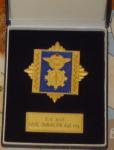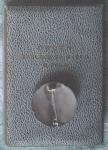
Valter
Active Contributor-
Posts
396 -
Joined
-
Last visited
-
Days Won
1
Content Type
Profiles
Forums
Blogs
Gallery
Events
Store
Everything posted by Valter
-
Various - Eastern Europe ODM - A Magpie's Collection
Valter replied to Hugh's topic in Southern European & Balkan States
You have a tremendous collection here, Hugh! About the Yugoslav flag order - it's the later model with painted (not enammeled) flag, so it was probably awarded from late 60's-70's onward. I doubt it was awarded to Soviet serving in Afganistan - it's mostly diplomatic award and for senior ranks, so even if some Soviet official would get it, he would probably not not carry it into war, but leave at home. More likely is it was awarded to some Afghan or Pakistan diplomat. Tito visited Afganistan and pakistan in 1968, so it might originates from this visit, or later. -
Soviet While on vacation
Valter replied to Stijn David's topic in USSR: Soviet Orders, Medals & Decorations
I agree about OGPW's. On his left breast, there are a medal for bravery, 100'th anniversary of lenin's birth, Veteran of labor medal and 100'th anniversary of Zhukov's birth - this is a post-soviet "semi-official" veteran's association award. -
Indeed! It reads: (up) MINRYBHOZ SSSR = Ministerstvo ribnego hozjajstva (??) = Ministry for fishing economy; (down): ZA BEZAVARIJNUJU RABOTU = For accident-free labor. A very nice badge! The first one is for 100th anniversary of Lenin's birth, but I'm not sure if this is Soviet - the pin and hinge assembly doesn't look Soviet to me, but there were very many tinnies around. Regards, Valter
-
It can be both WW2 or WW1/WW2 bar. Usually in peacetime an officer can reach a rank of major in 12-15 years. If "your" officer started his career in 20's or 30's he would have only WW2 ribbons, of course (and probably some annexation medal); if a GJ officer would serve in WW1 and continued thru all the Weimar period, he would probably reach a higher rank, but if an WW1 fighter (not necessary an officer) would reactivate in Wehrmacht or Reichswehr after a certan period of civilian life, he could have WW1 medals as well as WW2. In this case, he would be around 45 years old and I'm not sure if these old men served in GJ truppen - maybe on some staff or rear duty?
-
Yugoslavia Miniatures - prototypes or moulds?
Valter replied to wlodzimierz's topic in Southern European & Balkan States
I think this is the best explanation. The upped ones are probably "patrix" (the opposite of "matrix"), and the deeped ones are matrix (molds). The concentric circles are from some kind of sanding/grinding machine or lathe, and those won't be used if these are unfinished miniatures. Is the material hard or soft? -
Yugoslavia Awarding Tubes
Valter replied to wlodzimierz's topic in Southern European & Balkan States
This will surely be an amazing book - even comparing to books about other countries militaria!! Can't wait for release, and I would surely like it more being 1100 than less pages, but even 700 IS huge. And the pictures are excellent too! -
Yugoslavia Primeran vojnik breast badge
Valter replied to SasaYU's topic in Southern European & Balkan States
As you can see, the "award" criteria are pretty loose (as for many Yugoslav decorations and awards) so there was certainly a space for some arbitrary decisions. As far as i spoke with several ex-JNA servicemen, they usually had to get an average "excellent" grades (there were grades in JNA like in school, for several both theoretical and practical subjects, as tactics, shooting, topography, gym, moral-political education etc), to be of proper political beliefs and irreprochable behavior. -
There were two groups of these documents indeed: for the "fallen fighters", which includes also non-combatant members of partisan units (i.e. medics), and the other type for "victims of fashist terror", which includes those (civilians) killed by occuaption forces and collaborationists, those who died/were killed in concentration camps (like Sebastians 2nd one), died in prisons etc. see: Švajncer, Odlikovanja in znaki na Slovenskem, 1978 (in Slovenian only, with short summary in german, russian and english) I'm not sure what if a partisan fighter was captured and later died in concentration camp, but he would probably go into 2nd cathegory. These documents were given to families of the fallen / dead. There were no official benefits linked to this "spomenica", but there were certain benefits and social allowances available for both survived partisan fighters and resistance members, as well as families of those fallen/died. As a matter of interest, there were several categories of disabled (invalids) in former YU: "military war invalids" (wounded partisan fighters), "civil war invalids" (civilians wounded by bombing etc., or after the war by unexploded war remains), "military peaceful invalids" and all the others; as you probably guessed, the first cathegory got the best treatment and more rights than others. As far as I know, this document was not necessary for getting these rights, as there were other (more humble) papers and ID's, but these "spomenica's" were intended to be put on the wall - you often find these framed and or (unfortunately) stained/faded from being exhibited for a long time. Regards, Valter
-
A very BAD enamelling business, not only morally, but also technically! As was already concluded, these "prototypes" are poor fakes. There were no decorations (orders, medals) on federal level that would be made specifically for a certain branch of service. And in the armed forces, the main and only way of "national politics" was brotherhood and unity. So it would be completely against this spirit to make a national decorations for military merit. I'm just explaining that to make clear why these two fantasy pieces can't go into Yugoslav system of awards. Regards, Valter
-
German medal 1914-1918, please help me!
Valter replied to Humanity's topic in State, Civil Awards & Decorations
Detev Niemann's big catalog has plenty of these veteran awards... I'll check when I come home. Regards, Valter -
I researched a bit about the documents and found the following: According to "Yugoslav decorations Act" (Zakon o odlikovanjih SFRJ, slu?beni list (Official gazette) no. 40, 1973, p. 1224-1228), article 15: Decorated person gets "potrdilo" receipt/copnfirmation/affidavit, but president of the republic can decide, that for the highest decorations there will be also a special document ("diploma"). Legislation changed in 1985 (Official gazette no. 25, 1985, p. 785-787): decorated person gets "potrdilo" as before, but presidency of the country (a collective ruling body after Tito's death) will make a list of decorations for which also a formal document ("diploma") will be issued. To make things shorter, small A5 paper "potrdilo" IS offcial document, at least from 1973; bigger, more elaborate paper is issued only for some (higher) decorations. Which are these (and for situation before 1973), I have yet to research :speechless:
-
Yes, screwback variations are always numbered, and you also find (parts of) numbers on ex-screwbacks converted to pinback (the same story with brotherhood). The award year is very difficult to tell, you can only roughly estimate. In later years, batches of orders were shipped to federal republics, and somewhere they got newer pack, somewhere old stocks, somewhere they awarded more pieces and requiested new shipment... I hope you imagine what I mean. I spoke about that subject with many collectors from ex-yugoslav countries and so far noone knows anything about any centralized register of award numbers. In early years, the award number was entered in the document, but in later there're no such numbers in documents (there's only number of decree to award the order/medal, not the actual order's serial number).
-
Yugoslavia Yugoslavia ribbon bars
Valter replied to Noor's topic in Southern European & Balkan States
Nice bars there, gentlemen! Noor, bar no.4 is turned upside down on the pic. I also posted two examples in that thread: http://gmic.co.uk/index.php?showtopic=34482 Yugoslav ribbon bars are quite similar to each other, as most of the officers got similar awards during their careers... And in early days there were no ribbon bars, they just wore full decorations or nothing. Vast majority of combined ribbon bars are sewn-on type, the ones with metal pins were given together with an award, but not always. These single bars were used mostly by civilians (or just kept in the box with the decoration), or officers with only one award. Officers with more awards purcased these sewn-in pieces. -
Yugoslavia Air Force Academy Plague
Valter replied to gro's topic in Southern European & Balkan States
It bears a second type of pilot's academy badge, so its' probably from 1973/4-1991 period. It's probably not silver (ckeck for hallmarks), but silvered or just patinated tombak or whatever. I don't think these plaques were awarded to all graduates, but rather to professors and other employees of the academy, or some distinguished personalities that have some merit for the school. Graduates got only academy badges. Here is another plague from (general) air force and anti-aircraft defence academy, awarded to regular professor Dragoljub Gajić, graduated engineer; since he has no rank, he was probably a civilian teacher of some technical subject. -
Yugoslavia Is This A POSSIBLE Yugoslav Group?
Valter replied to seb16trs's topic in Southern European & Balkan States
A very nice and totally correct group! And the reason, why two orders were awarded so closely together: yugoslav orders/medals were mostly awarded on national holidays, and 4th July was Resistance fighter's day (Dan borca) - no wonder on that day MANY partisan veterans were awarded, especially in the early years after the war. She was probably "missed" or "skipped" in the first days after the victory, so she got these two together to correct the "mistake" - a common practice. To the contrast, most peace-time military service awards (ie. Military merit order and medal, Order of people's army) you'll find awarded around 22nd december, which was the Army day (Dan JNA). -
Yugoslavia Partisanska Spomenica 1941 Type 2
Valter replied to wlodzimierz's topic in Southern European & Balkan States
about the markings on awards - I'm not sure about guns, and I never heard about any official control organisation regarding decorations (again, guns may be a different story) on Spomenica's, you'll usually find one of these: BK = Braća Knaus (Brothers Knaus, Zagreb) GK = Griesbach und Knaus (an earlier version of above; although a (partly) GERMAN name, it appears on some earlier Spomenica's ) IKOM = Industrijska kovnica Ore?kovič Marko (Industrial forgery Ore?ković Marko, a later marking) -
Yugoslavia Hat badge or collar badge, opinions please
Valter replied to Brian Wolfe's topic in Southern European & Balkan States
Very nice pictures, Sa?a! However, I must make a small correction: this cap badge (for field cap, not peaked one) is NOT for guards units (gardijske jedinice), but for so-called "proletarian" troops (proleterske jedinice). They were (almost) the same as normal yugoslav army troops, except they were bearing the tradition of elite/better partisan units, that have gotten honorary title "proletarian" during WW2. They were believed to be somehow better than "regular" (non-proletarian) units, but in reality that was dubious, at least in last years/decades of Yugoslavia. The only distinction in uniform was that hammer and sickle in the star.





